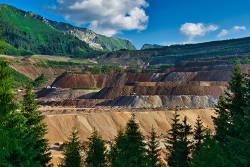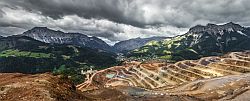Erzberg
Useful Information
| Location: |
Vordernberger Straße 55, 8790 Eisenerz.
A9 (E57) exit Reithtal, B146 east through Admont and the Gesäuse to Hieflau, turn right on B115 to Eisenerz. (47.5397764, 14.8976254) |
| Open: |
Besucherzentrum:
MAY to OCT daily 8:30-16:30. Schaubergwerk: MAY to OCT daily 8:30-15. [2025] |
| Fee: |
Schaubergwerk:
Adults EUR 23.50, Children (16-20) EUR 19, Children (4-15) EUR 11.50, Children (0-3) frei, Seniors (65+) EUR 21. Hauly Abenteuerfahrt: Adults EUR 23.50, Children (16-20) EUR 19, Children (4-15) EUR 11.50, Children (0-3) frei, Seniors (65+) EUR 21. Kombiticket Hauly + Schaubergwerk: Adults EUR 36, Children (16-20) EUR 32, Children (4-15) EUR 18, Children (0-3) frei, Seniors (65+) EUR 34. Kombiticket Hauly + Sprengung: Adults EUR 34, Children (16-20) EUR 27.50, Children (4-15) EUR 17, Children (0-3) frei, Seniors (65+) EUR 31. Kombiticket Hauly + Schaubergwerk + Sprengung: Adults EUR 44.50, Children (16-20) EUR 38, Children (4-15) EUR 25.50, Children (0-3) frei, Seniors (65+) EUR 41. Freilichtausstellung Oswaldirücken: Adults EUR 14, Children (16-20) EUR 11, Children (4-15) EUR 7, Children (0-3) frei, Seniors (65+) EUR 12. [2025] |
| Classification: |
 Iron Mine Iron Mine
|
| Light: |
 Incandescent Incandescent
|
| Dimension: | |
| Guided tours: |
Schaubergwerk:
D=90 min.
Hauly Abenteuerfahrt: D=60 min. |
| Photography: | |
| Accessibility: | no |
| Bibliography: | |
| Address: |
VA-Erzberg GmbH, Erzberg 1, 8790 Eisenerz, Tel: +43-3848-3200.
E-mail: |
| As far as we know this information was accurate when it was published (see years in brackets), but may have changed since then. Please check rates and details directly with the companies in question if you need more recent info. |
|
History
| 1171 | First written mention. |
| 1287 | Steyr receives the Great Privilege from the Prince Regnant for trading in Innerberg iron. |
| 1314 | Leoben receives the Great Privilege from the Prince Regnant for trading in Vordernberg iron. |
| 14th | century Mining of iron ore, production of pig iron and further processing regulated by decree of the Prince Regnant. |
| 1448 | Iron regulations issued. |
| 16th | century Start of tunnel construction by imperial decree. |
| 1720 | Introduction of powder blasting. |
| 1820 | Start of open-cast mining. |
| 1899 | Underground mining ceased. |
| 1932 | Underground mining resumed. |
| 1970 | Introduction of self-propelled drilling equipment with a borehole diameter of 15 cm. |
| 1986 | Underground ore mining finally ceased. |
| 1988 | Show mine opened. |
Geology
The Erzberg is considered to be the largest siderite deposit (FeCO3) in the world, but also contains ankerite and ferruginous dolomite. It is located in the Grauwackenzone (greywacke zone) between the Central Alps and the Northern Limestone Alps, a narrow strip of Palaeozoic rock from the Arlberg to the Enns Valley. It consists of dark greywackes, phyllites, slates, metamorphic volcanic rocks, as well as weakly metamorphic limestones (marbles) and quartzites. They were formed from the Ordovician to the Carboniferous and were already folded during the Variscan orogeny. In the Mesozoic they formed the geological base of the shelf of the western Tethys, on which the Mesozoic limestones of the Limestone Alps were deposited. Both together were then folded during the Alpine orogeny. The rocks are rich in mineral resources (iron, copper, magnesite, graphite) and are generally softer than the limestone, which is why they mainly form rounded, gentle hilltops with sparse forestation.
The Eisenberg consists of a mixture of various ores and dolomite, and has a rather low iron content of 33.5 %. The iron content varies between 22 % and 40 %. Historically, it was primarily the richer ores that were mined, first in pits and later underground. Open-cast mining has only been used again since 1820, although this is only possible on a large scale with modern machinery.
Description


As its name suggests, the Erzberg (Ore Mountain) is a mountain consisting of ore. The village of Eisenerz (lit: iron ore) lies at the end of a valley where the Erzberg is located. The entire mountain is being mined in a huge open-cast mine. Today, the original mountain peak has already disappeared, and the remains of the mountain look like a large pyramid with huge steps. These steps are plateaus that have been created by step-shaped mining in the open-cast mine since 1890. Vertical boreholes are drilled at a certain distance from the edge of the step and then filled with explosives. After the explosion, the loose material is loaded from the lower step onto huge trucks with excavators and transported away. After the loose material has been removed, the step has receded a little. This process takes place on all steps, so that they have a more or less constant width overall. Around 1907, there were 60 steps with a height of 12 m. In 1928, the number was halved to 30 steps with a height of 24 m in order to optimize the use of modern machinery. The steps are named after saints or distinguished miners.
Historically, mining was first carried out in Pingen (pits), ancient open-cast mines. There is also a well-known legend about the discovery of the ore. It was depicted on a stamp issued by the Austrian Post in 2022.
A group of fishermen once cast a net into the nearby Leopoldsteinsee lake. After a while, they pulled it out of the water and found a water sprite in the net. Frightened, they tried to kill him, but the water sprite begged them not to kill him. He offered them 100 years of gold, 1,000 years of silver, or infinite iron. The fishermen chose iron, and the water sprite pointed to a mountain and disappeared into the water. This is how the men discovered the iron mountain, but the water sprite returned to the Wassermannsloch and was never seen again.
There are variations of the legend; another version claims that the water sprite was deliberately caught with the help of a pitch-soaked cloak.
The nearby karst spring
 Wassermannsloch
mentioned in the legend is definitely worth a visit.
Wassermannsloch
mentioned in the legend is definitely worth a visit.
The oldest archaeological finds are three smelting furnaces from Roman times on the Feistawiese. Mining probably began in Roman times, as the Romans needed iron for the weapons of the Roman army. Ferrum Noricum (Noric iron) was mentioned by Pliny the Elder, but whether he was referring to the Erzberg is disputed. The year 712, often cited for the start of mining during the last 400 years, is obviously nonsense. It is unclear whether this is pure invention or whether there was actually evidence of mining in the Slavic period that has been lost. The Erzberg was first mentioned in a document in 1171. In the 14th century, the upper half of the mountain was mined from Vordernberg in the south, and the lower half from Eisenerz, which was then called Innerberg. This was regulated by the sovereign prince, as was the division of the sales areas, with Innerberg covering Northern Europe and Vordernberg covering Southeastern Europe. From the 16th century onwards, mining was carried out underground in a mine by imperial order. This historic mine can now be visited on an underground tour called “Im unterirdischen Erzberg Labyrinth” (In the Underground Ore Mountain Labyrinth). The tour presents the historical mining methods. The history of the ore mountain, the legend of its discovery, and a simulation of a blasting operation are also shown.
Modern open-cast mining began in 1820 and has been technologically improved several times over the years. Originally, the blast holes were drilled by hand, but from 1908 onwards, pneumatic percussion drills were used. Later, drilling cranes were used, and since 1970, self-propelled drilling rigs with a drilling diameter of 15 cm. The ore and spoil were transported by mine trains and inclined elevators, initially steam-powered, later electric. Since 1951, heavy-duty trucks have been used because they do not require rails; the last rails were removed in 1981. This open-cast mine is shown on a trip on one of the large trucks called Hauly. This tour is also known as Abenteuerfahrt (adventure ride). The huge 1,217 hp truck was converted for this purpose and, with a height of 4 m, offers a very good view. It is also known as the “world’s largest taxi.”
In addition to the two guided tours, there is also the Freilichtausstellung Oswaldirücken (open-air exhibition) at 878 m above sea level, featuring old mining machinery and modern art elements. Excavators, mining trains, and drilling machines can be viewed here, as well as the still active mining operations with wheel loaders and trucks. The open-air exhibition is located in the open-cast mine and visitors are taken there by Abenteuer Erzberg. Visits are not possible in rainy weather.
Special events are the Sprengungen (blasting operations), which can be observed both from the open-air site and from the Hauly. Here you can see how 80,000 tonnes of rock are loosened by a large blast. The details of the blasting process are explained. These blasts take place every Thursday at 8.30 am.
But there is more to see, although these are not regular tours. The Zentrum am Berg (mining centre) of the Montanuniversität Leoben is located underground in the mine. It is used for research, but also for training students. Guided tours are only offered on four days of the year. A visit to the Hochofenmuseum Radwerk IV (Blast Furnace Museum) in Vordernberg is even more difficult and is only possible for groups on request. This visit is only possible as part of a combined tour with the show mine tour and the Hauly ride. The blast furnace museum has the only charcoal blast furnace in the world that has been preserved in its entirety.
 Search DuckDuckGo for "Erzberg"
Search DuckDuckGo for "Erzberg" Google Earth Placemark
Google Earth Placemark OpenStreetMap
OpenStreetMap Erzberg mine - Wikipedia (visited: 02-OCT-2025)
Erzberg mine - Wikipedia (visited: 02-OCT-2025) Abenteuer Erzberg (visited: 02-OCT-2025)
Abenteuer Erzberg (visited: 02-OCT-2025)
 Index
Index Topics
Topics Hierarchical
Hierarchical Countries
Countries Maps
Maps